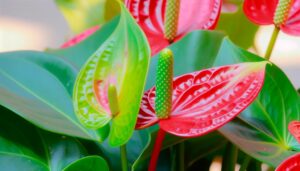Is the Anthurium Plant Poisonous? Yes!
Yes, the Anthurium plant, scientifically known as Anthurium andraeanum, is poisonous. It contains needle-like calcium oxalate crystals called raphides.
Ingesting any part of the plant can cause oral irritation, severe pain, and swelling in humans and animals. Symptoms include burning sensations, difficulty swallowing, and vomiting.
Skin contact may result in dermatitis and irritation. Pets are especially vulnerable, showing signs like excessive drooling and pawing at the mouth if ingested.
Handle with care, wearing gloves and keeping the plant out of reach of children and pets. There’s much more to understand about these beautiful yet toxic plants.
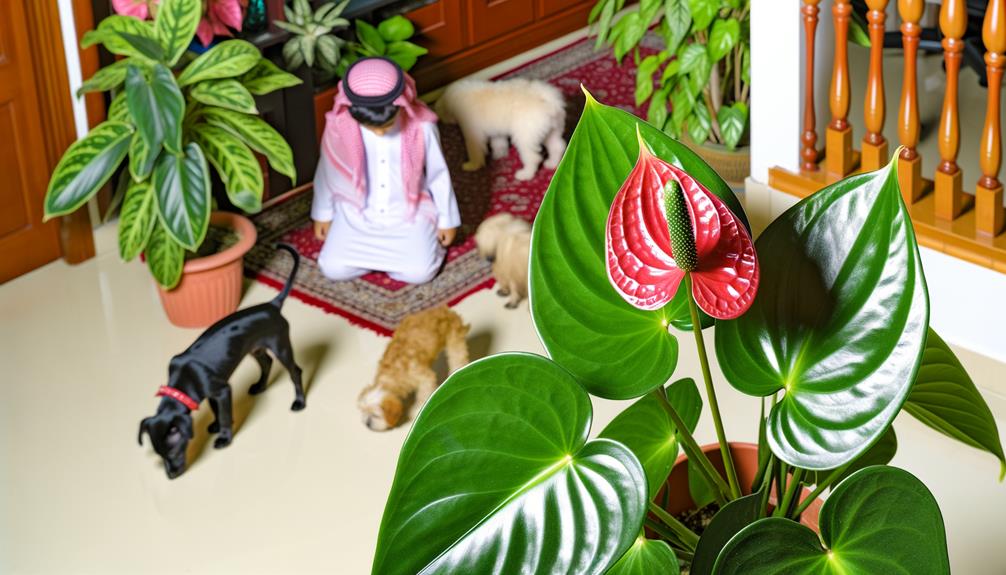
Key Takeaways
- Anthurium plants contain toxic calcium oxalate crystals.
- Ingestion causes oral, throat, and gastrointestinal irritation.
- Skin contact with sap can lead to dermatitis and irritation.
- Symptoms include pain, swelling, and difficulty swallowing.
- Pets are at risk and may exhibit drooling, vomiting, and pawing at the mouth.
Understanding Anthurium Plants

Anthurium plants, scientifically known as Anthurium andraeanum, are tropical perennials renowned for their glossy, heart-shaped leaves and vibrant spathes.
When caring for these plants, you’ll need to provide indirect light, high humidity, and well-draining soil.
Regular watering is essential, but avoid waterlogged conditions to prevent root rot. Fertilize monthly with a balanced, water-soluble fertilizer to support their growth.
For decorative purposes, Anthurium plants are exceptional due to their striking appearance. Their vividly colored spathes, often mistaken for flowers, come in shades of red, pink, white, and green. These plants make elegant additions to indoor spaces, bringing a touch of tropical beauty.
With proper plant care, your Anthurium will thrive and continue to enhance your home’s aesthetic appeal.
Toxic Components
While Anthurium plants add a tropical flair to your home, it’s important to be aware of their toxic components.
The primary toxic element in Anthurium species, such as Anthurium andreanum, is calcium oxalate crystals. These needle-like crystals, known as raphides, can cause significant irritation.
When the plant’s tissues are damaged, these crystals can penetrate cells, leading to toxic effects.
Potential dangers include irritation of the mouth, throat, and gastrointestinal tract upon ingestion, as well as skin irritation upon contact.
Calcium oxalate toxicity manifests through symptoms like pain, swelling, and difficulty swallowing.
Understanding these toxic components helps you appreciate the beauty of Anthurium plants while being mindful of the potential risks they pose.
Risks to Humans
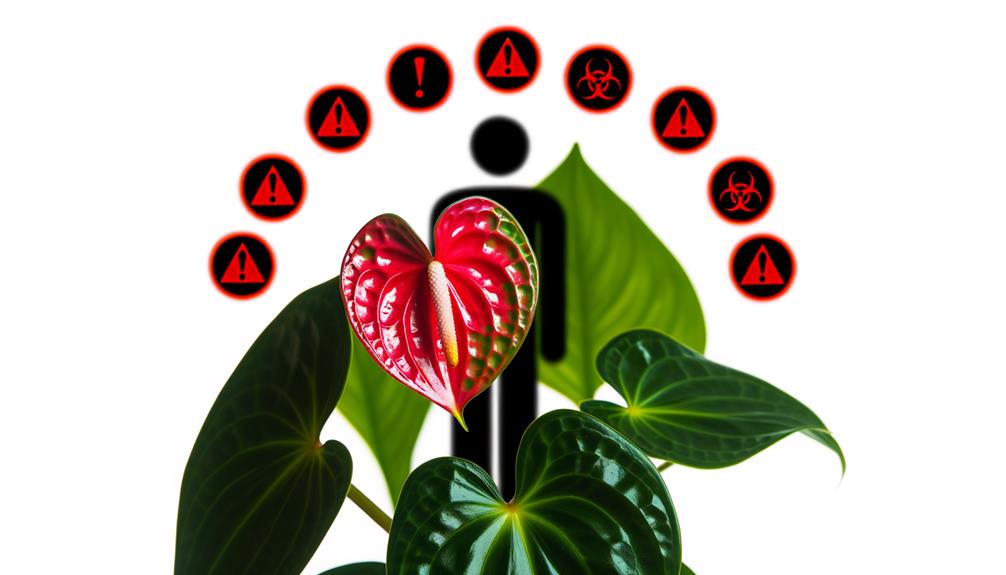
Exposure to calcium oxalate crystals in Anthurium species can cause a range of adverse effects in humans, including oral irritation, severe pain, and swelling. When caring for this plant, it’s essential to understand the health risks associated with handling it.
Direct contact with the sap or leaves can lead to dermatitis or other skin reactions. Always wear gloves when performing plant care tasks such as pruning or repotting.
Potential health risks include:
- Contact dermatitis from sap exposure
- Oral irritation if plant parts are ingested
- Severe swelling in the mouth and throat
- Intense pain due to the needle-like crystals
Symptoms in Humans
Symptoms in humans from Anthurium exposure often include a burning sensation in the mouth, difficulty swallowing, and severe irritation of the skin and eyes.
The plant’s calcium oxalate crystals can cause immediate discomfort. Contact with the sap can lead to dermatitis, while ingestion may result in swelling of the lips, tongue, and throat.
| Symptom | Description |
|---|---|
| Burning sensation | Intense oral pain due to calcium oxalate crystals |
| Difficulty swallowing | Throat irritation and swelling |
| Skin irritation | Dermatitis from sap contact |
| Eye irritation | Severe discomfort if sap enters the eye |
| Allergic reactions | Possible in sensitive individuals |
If you experience these symptoms, seek medical attention immediately. Contact poison control for specific treatment options to mitigate reactions.
Risks to Pets
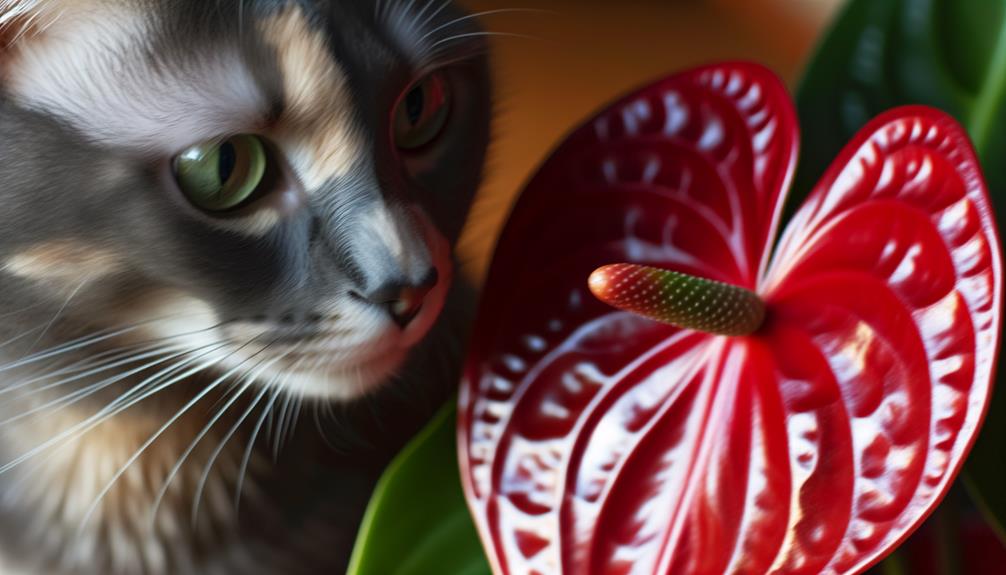
You should be aware that Anthurium plants, specifically Anthurium andreanum, pose significant risks to pets. Ingestion can lead to symptoms like oral irritation, excessive drooling, and vomiting due to calcium oxalate crystals.
Understanding toxicity levels and knowing emergency care tips can help you act swiftly to protect your animals.
Symptoms in Animals
When ingested by pets, Anthurium plants (Anthurium andraeanum) can cause severe oral irritation and swelling due to insoluble calcium oxalate crystals.
Symptoms you might observe include:
- Drooling: Excessive saliva production as a response to oral irritation.
- Pawing at the mouth: Indicating discomfort or pain in the oral cavity.
- Vomiting: The body’s attempt to expel the ingested plant material.
- Difficulty swallowing: Due to swelling and irritation in the throat.
If your pet shows these signs, seek immediate veterinary care. Early treatment can prevent further complications.
Preventing animal poisonings involves keeping Anthurium plants out of reach and educating yourself on toxic plants. Regularly inspect your home for potential hazards to safeguard your pets’ well-being.
Toxicity Levels
Anthurium plants (Anthurium andraeanum) present a high toxicity risk to pets due to their insoluble calcium oxalate crystals, which can cause serious health issues upon ingestion.
When your pet nibbles on these plants, the crystals can embed themselves in the mucous membranes, leading to intense pain and irritation.
Symptoms include drooling, vomiting, difficulty swallowing, and oral irritation. Understanding anthuriums is vital for responsible indoor gardening and plant care.
Keep these plants out of reach from pets to lessen toxicity levels. If you’re an indoor gardening enthusiast, consider safer alternatives or make sure that your Anthurium plants are in pet-inaccessible areas.
This proactive approach can prevent potential health risks and maintain a safe environment for your furry companions.
Emergency Care Tips
Given the high toxicity of Anthurium andraeanum to pets, immediate steps should be taken if ingestion occurs to lessen serious health consequences.
First, safeguard your pet’s Plant safety by removing the plant from their reach. Common symptoms include drooling, vomiting, and oral irritation.
To handle ingestion effectively, follow these steps:
- Call your veterinarian immediately for specific Treatment options.
- Rinse your pet’s mouth with water to eliminate any plant residue.
- Monitor for symptoms of distress, including swelling or difficulty breathing.
- Avoid inducing vomiting unless instructed by a professional.
Prevention measures are essential to avoid these Household dangers. Keep Anthurium plants out of areas accessible to pets and educate household members about the risks.
Symptoms in Pets
If your pet ingests parts of an Anthurium plant (Anthurium andraeanum), you may notice immediate symptoms such as oral irritation, excessive drooling, and difficulty swallowing.
These reactions are due to insoluble calcium oxalate crystals found in the plant.
It’s essential to seek veterinary care promptly to mitigate severe complications.
Common Toxicity Signs
Pets that ingest parts of the Anthurium plant often exhibit symptoms such as drooling, pawing at the mouth, and difficulty swallowing due to the presence of insoluble calcium oxalates.
These compounds cause intense irritation in the oral cavity and throat. Recognizing plant toxicity is pivotal for prevention.
If your pet encounters poisonous plants like Anthurium, knowing the signs can help with swift identification.
Look for:
- Vomiting: Frequent, sometimes foamy, vomiting.
- Lethargy: Unusual tiredness or lack of energy.
- Swelling: Noticeable swelling of the mouth, tongue, or lips.
- Loss of appetite: Reluctance to eat or drink anything.
Understanding these symptoms enables prompt action, ensuring your pet’s safety and well-being.
Emergency Actions Needed
When you observe symptoms of Anthurium toxicity in your pet, immediate action is important to mitigate the effects of the plant’s harmful compounds.
Symptoms may include oral irritation, excessive drooling, vomiting, and difficulty swallowing due to calcium oxalate crystals.
To initiate immediate treatment, first rinse your pet’s mouth with water to remove any plant residue.
Avoid inducing vomiting unless instructed by a veterinarian. Contact your vet or an emergency animal clinic promptly for further guidance.
Administering activated charcoal may help absorb toxins, but professional advice is crucial. Keep your pet hydrated and monitor for worsening symptoms. Quick response can greatly alleviate the impacts of Anthurium plant toxicity.
First Aid Measures
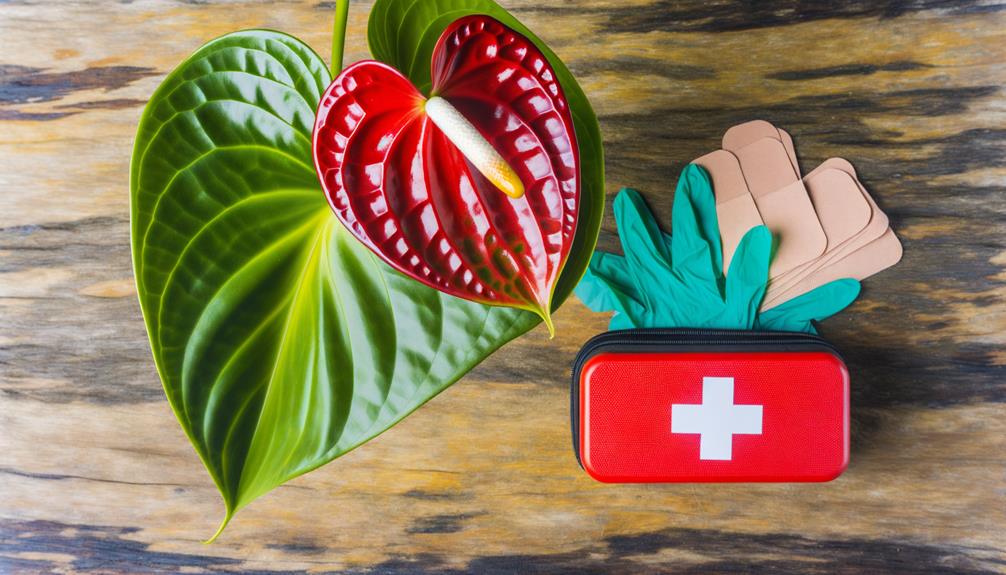
In the event of ingestion or contact with Anthurium plant parts, immediate first aid measures are crucial to mitigate potential toxic effects.
Follow these first aid procedures and safety precautions:
- Ingestion: Rinse the mouth with water and avoid inducing vomiting. Seek medical advice immediately.
- Skin Contact: Wash the affected area thoroughly with soap and water. If irritation persists, consult a healthcare provider.
- Eye Exposure: Rinse eyes with lukewarm water for at least 15 minutes. If discomfort continues, seek medical attention.
- Inhalation: Move to fresh air and monitor for symptoms. Seek medical help if respiratory issues arise.
For prevention tips and treatment options, always handle Anthurium, known scientifically as Anthurium andraeanum, with care. Keep the plant out of reach of pets and children to guarantee safety.
Safe Handling Tips
When handling Anthurium andraeanum, always wear protective gloves to prevent skin irritation from calcium oxalate crystals.
Wash your hands thoroughly with soap and water after any contact with the plant to remove any lingering sap.
Additionally, keep the plant away from pets to avoid ingestion risks.
Wear Protective Gloves
Wearing protective gloves is essential when handling Anthurium plants due to the presence of calcium oxalate crystals, which can cause skin irritation.
You should always prioritize safety precautions to avoid direct contact with the plant’s sap. These microscopic crystals can penetrate the skin, causing discomfort and potential allergic reactions.
Consider the following protective gear and safety measures:
- Nitrile gloves: Provide a strong barrier against the plant’s irritants.
- Long sleeves: Protect your arms from accidental contact.
- Safety goggles: Shield your eyes from sap splashes.
- Apron: Prevent sap from staining and irritating your clothes and skin.
Wash Hands Thoroughly
After removing your protective gloves, it’s important to wash your hands thoroughly to eliminate any residual calcium oxalate crystals.
These needle-like crystals, found in Anthurium plants, can cause skin irritation. Use soap and warm water, scrubbing for at least 20 seconds, particularly around fingernails and between fingers.
Proper care ensures you can continue to enjoy the plant benefits without jeopardizing your health.
Anthurium plants (Anthurium andreanum) are known for their striking, heart-shaped leaves and long-lasting blooms. They purify air by removing toxins, promoting a healthier living environment.
| Step | Action | Duration |
|---|---|---|
| 1 | Remove gloves | Immediate |
| 2 | Use soap and warm water | Continuous |
| 3 | Scrub for at least 20 seconds | 20 seconds |
Keep Away From Pets
Make certain you place your Anthurium andreanum out of reach from pets, as ingestion can lead to serious health issues due to its toxic calcium oxalate crystals. Pet proofing homes is essential to prevent accidental ingestion.
Here are some tips:
- Elevate Plants: Position your Anthurium on high shelves or hanging planters.
- Use Barriers: Install pet gates or use plant stands with built-in barriers.
- Choose Safe Locations: Place plants in rooms that pets can’t access.
- Educate Household Members: Guarantee everyone in the home is aware of plant toxicity awareness and the dangers posed by Anthurium.
Child Safety Precautions

To safeguard your child’s safety around Anthurium plants, it’s crucial to acknowledge the risks posed by the plant’s calcium oxalate crystals. These needle-like crystals can lead to severe irritation, swelling, and pain if ingested or touched.
To reduce these risks, maintain constant child supervision and implement effective safety measures.
Position the Anthurium plant out of reach, preferably on high shelves or in hanging baskets. Educate your child about the plant’s hazards, emphasizing that it’s not for touching or tasting.
Additionally, make sure to wash hands thoroughly after handling the plant to prevent accidental transfer. By following these precautions, you can admire the beauty of Anthurium plants while protecting your child’s well-being.
Pet Safety Precautions
Just like with children, keeping Anthurium plants away from pets is essential due to the presence of toxic calcium oxalate crystals.
These crystals can cause severe irritation and swelling in your pet’s mouth, throat, and digestive tract, leading to serious health issues.
To mitigate plant toxicity and household dangers, take these precautions:
- Elevate: Place Anthurium plants on high shelves or hang them out of reach.
- Barriers: Use pet-proof barriers or enclosures around plant areas.
- Training: Train pets to avoid plant-rich zones using deterrent sprays.
- Monitoring: Regularly check for any signs of chewing or ingestion.
Safe Alternatives
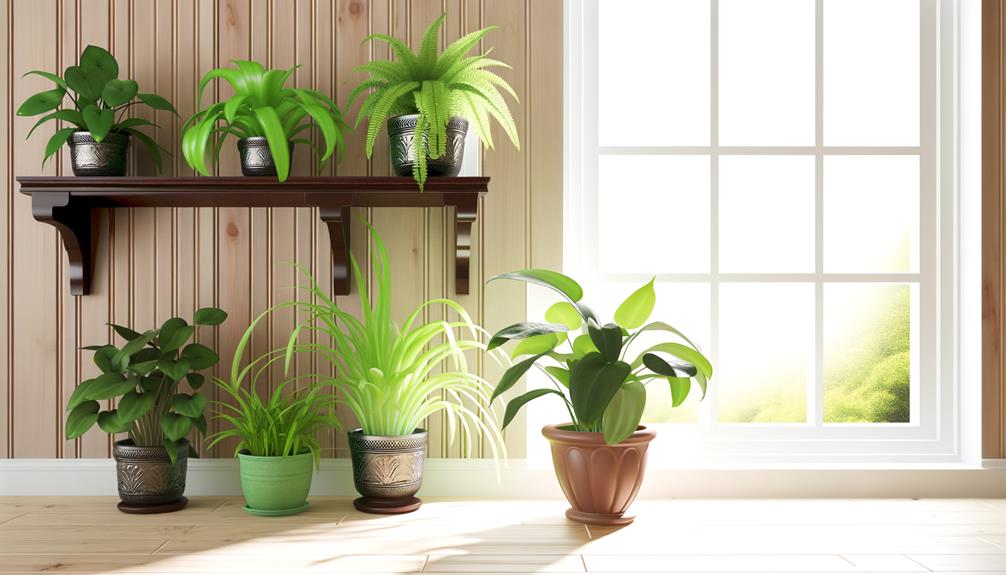
If you’re seeking pet-friendly alternatives, consider non-toxic plants like the Spider Plant (Chlorophytum comosum) or the Boston Fern (Nephrolepis exaltata).
Spider Plants are recognized for their air-purifying characteristics and flourish in indirect sunlight, making them suitable for various indoor settings.
Boston Ferns, with their lush, arching fronds, introduce a hint of greenery while being safe for both pets and children.
For safe handling, make sure these plants are placed in stable, secure pots to prevent tipping.
Regularly check for any fallen leaves that curious pets or children might ingest.
Conclusion
In caring for your Anthurium, you must remember that it’s as treacherous as a concealed thorn. The plant contains calcium oxalate crystals, posing risks to humans and pets alike. Symptoms like oral irritation and nausea can occur if ingested.
Handle with gloves, keep out of children’s and pets’ reach, and consider safer alternatives like the spider plant (Chlorophytum comosum).
Your watchfulness guarantees a beautiful, yet safe, living space for everyone.






